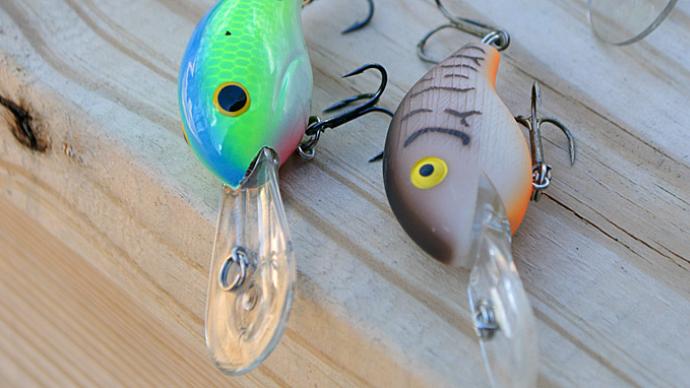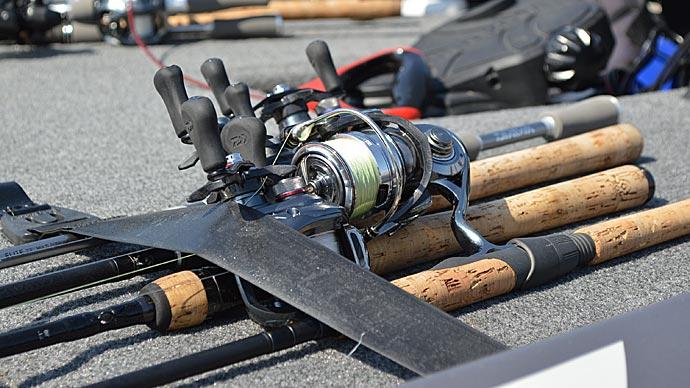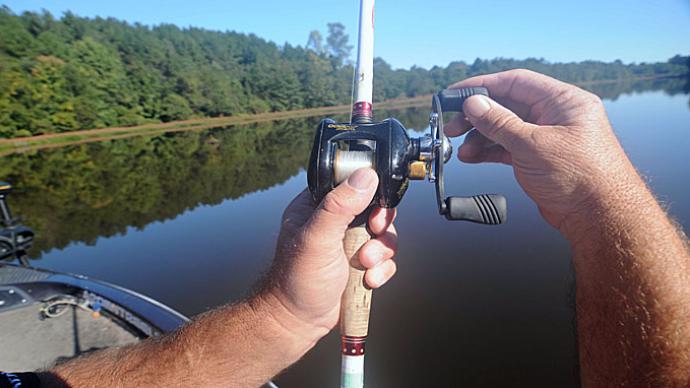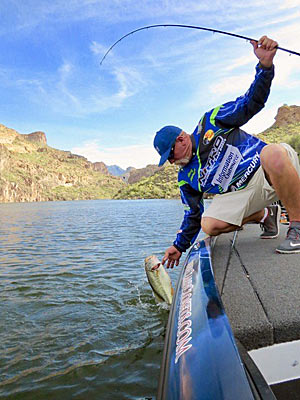
A good bass fishing rod can be very expensive, so you should know precisely what you need before shopping. But what do you need? We’ve all seen photos of the pros with eleven rods on deck, but if you’re starting and don’t have thousands to shell out on rods for every technique, what’s the bare minimum you can squeak by? For starters, no one rod will allow you to do everything from quarter-ounce pea heads to foot-long swimbaits. But according to California bass pro Gary Dobyns (one of the first bass fishermen to reach the magic score of a million bucks in tournament winnings), you can start with just three rods that will cover many of the techniques you need to put bass in the boat.
Gary is a bit of a rod fanatic, and he started his own company, Dobyns Rods, to build the perfect rods for bass fishermen. If you can’t find his rods in your local store, check out dobynsrods.com. Sometimes deciphering rods can be difficult, but Gary’s are pretty straightforward. The number is simply length and power. For instance, a 703 is a seven-foot, three-power rod. A 765 would be a seven-foot, six-inch, five-power rod. Pretty simple, right? Except what is power? And what about action?
Rod Power and Action
Rod power describes how resistant it is to bending. Terms like ultra-light, medium, and heavy are words describing power. For instance, if you see a rod that says MH, it is a medium-heavy power rod. In a Dobyns rod, that would be a 4. Ultra-light rods are perfect for very light line and light lures. Light rods can handle lures in the 1/16-3/8 oz range, etc., up to the heavy rods for heavy lures or flipping. Generally speaking, a rod will have the lure weight range printed on the blank, along with the power and hopefully the action. Many even print the rod's technique, such as crankbaits, jigs, worms, etc.
Action is basically “where does the rod start to bend?” Fast action means that the bend is mainly in the last third or so of the rod, while a medium or moderate action means the bend starts about halfway down. An extra fast action will mean just the last few inches of the rod bend. An extra slow action rod will have bend to it almost down to the handle. Where the bend happens is important because the less bend a rod has, the better you can feel any bites. However, a stiffer rod doesn’t cast as well, but it is easy to set the hook with. If you’re looking at a rod and it doesn’t say what the action is, have a buddy bend the tip down and look at where it starts to curve.
Three Rods For The Beginner
NUMBER ONE: A medium power, fast action spinning rod.
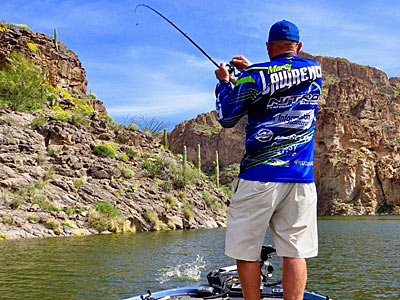
With a rod like this, you can do many different things, like split-shotting, drop-shotting, Senkos, small jigs – pretty much any small or weightless bait that might be hard to throw with a baitcaster. You can even throw flukes, twitch baits, small spinnerbaits, and light Texas-rigged baits with this rod, Chatterbaits, and topwater lures. Spinning reels are easier for a beginner to use than baitcasters are, so a good spinning rod is ideal for a beginner. Gary likes longer rods, so he suggests a 7-foot, medium-heavy, fast-action spinning rod that will handle 10- to 17-pound-test line and one-quarter to three-quarter ounce lures.
Pair this rod with a reel in the 2500 to 3000 size range. (It may be called 25-30) – the bigger the spool, the less twist you’ll have to deal with. You’re looking for a reel designed for about six- to eight-pound-test line. And here’s a hint: if you have a problem with loops in your spinning reel line, try holding the line between your fingers in front of the reel as your reel in to re-cast. The line is taut, like when a fish is on it, but it doesn’t loop. If I keep the handle butted up against my body, I can keep one hand on the line and one hand on the handle to hold the line while I reel. Keep it taut, and you’re golden.
NUMBER TWO: A medium-heavy (3 power), fast-action spinnerbait rod.
According to Gary, this baitcasting rod allows you to throw just about anything. It can handle Texas rigs, spinnerbaits – pretty much anything you’d use on 10- to 12-pound-test line. The fast action makes it easy to cast with and has enough power to get a good hookset. This rod is the workhorse in your arsenal. Pair it with a sturdy reel in the 6.1:1 to 6.3:1 range. This number, by the way, means that for every complete turn of the handle, the spool turns 6.1 times. Or 6.3 times or whatever. Gary says that except for jig fishing and a few other things, you don’t need a super-fast reel. He says that most people fish too fast, and putting an 8:1 reel on your spinnerbait rod makes it worse. A 6.1 or 6.3 gives you power and speed for almost anything you’re throwing.
NUMBER THREE: A heavy power, fast action, 7-foot or 7-foot, 3-inch baitcasting rod.
With 12- to 15-pound-test line spooled on a sturdy reel, this rod will be your go-to stick for frogs, heavy Texas rigs, jigs, deep worms, and bigger baits. I use this one for flipping, dragging football jigs down in the rocks, throwing heavy Texas rigs to shore, and fishing giant worms deep.

Those three rods are the ones Gary considers essential for any bass fisherman just starting. But of course, once you get into it, you will want to add a few. As stated before, you can do pretty much anything with the rods above, but adding another rod now and then as you learn new techniques will make it easier to fish.
Rods For Specialty Techniques:
NUMBER FOUR: A crankbait rod. This will be a medium-heavy, moderately fast action rod. There’s a fine line here. You want some give in the rod, so you don’t yank the bait out when the fish hits, but you do want to be able to make long casts. Most guys use 10-pound-test line for cranks and don’t use a fast reel. Gary says you don’t use this rod for spinnerbaits; use it for cranks and small poppers, just about anything with a treble hook. In a Dobyns Rod, this would be a 705CB (for crankbait). Get a rod that says it is precisely for crankbaits. Many bass fishermen are stepping back into time and getting fiberglass crankbait rods. They work great, but they are heavy and can wear you out by the end of the day.
NUMBER FIVE: Long, heavy power, extra fast action baitcaster.
This rod will handle 10- to 20-pound-test line and one-quarter to one-ounce lures. It’s excellent for Carolina rigs, jigs, some Senko presentations, Texas rigs, etc. For fishing Carolina rigs and Texas rigs, you often have a lot of line out, so pick a reel that holds a lot of line. You can put a faster reel on this one since you won’t usually be using to reel to work the lure. A faster reel on this one helps you get control of the fish fast, especially when you have a lot of line out.
With these five rods, you’ll have about 90% off all bass fishing techniques covered, says Dobyns. As you add to your arsenal of techniques and start cashing tournament checks, invest some of your winnings in specialty rods like a dedicated flippin’ stick, a swimbait rod, and a rod for hollow body frogs. For flipping, you want a long rod – at least 7’6”, and it should be a heavy power, fast action rod. If you want to use the same rod for punching heavy grass, get it even longer – like 8 feet. This rod should be able to handle 15- to 30-pound-test line. A swimbait rod is usually marked as such. Get one with a long handle to get extra leverage when reeling the big ones in. It should handle baits from two to eight ounces, covering A-rigs. It’s a long (often over 8 feet), ultra-heavy power, fast action rod. Dobyns likes to have a special rod for hollow-body frogs: it has to have an incredible amount of power to get the fish and a ton of vegetation to the boat and a fast action to allow you to work the frog delicately over the pads. His frog rod is 7’3”. You can also throw small swimbaits with this rod, and in a pinch, you can use it for pitching and flipping.
A Word About Line

Dobyns uses fluorocarbon line on his spinning rods. The great thing about fluorocarbon is that it is invisible and very strong. He says lots of baits work well with braid, but if you only have the three main rods, get an extra 735 and spool 40- to 50-pound-test braid on that rod with a fluorocarbon leader. As for the braid itself, Gary believes that black is the best color. He’ll use a marker to color even brand new-braid black.
Keeping Your Rods Usable
Many rod lockers now have rod organizers, allowing you to store your rods each in its own little cradle. However, I know from painful experience that just because they are stored nicely doesn’t mean you can get them out quickly when you need them. It seems like I always need the one on the bottom, and if there is a crankbait rod in there with a bait on it, those treble hooks catch every line in the locker. It’s frustrating. Also, if you stick a rod into the locker in a hurry, you sometimes get it inside the line of another rod.
First, invest in some rod socks, and be religious about sliding each rod into its sock before you stow it in the locker. These things are worth their weight in gold – they keep your rods from getting tangled together. Secondly, do not put crankbaits in the rod locker. If a bait is tied on your crankbait rod, leave the rod out on the deck until you’re done for the day. Then cut the bait off and put the rod in a sock before stowing it. Crankbaits are the WORST for getting tangled in the line on your other rods, and they will also catch on rod socks. You can put many different things on the hooks, but it’s easier to make it a rule to keep them out of the rod locker.
It’s also an excellent idea to install gas pistons on your rod locker lid if you don’t already have them. I do not want to discuss how many rods I have broken because the lid slammed shut on them. Finally, resist the temptation to leave your rods in the locker while the boat is home. The heat will trash the line and could even damage the rods or their handles, especially in the desert where I live. Those little enclosed spaces get much hotter than the air outside, so bring them in and put them in a rod rack when you get home. I built my rod rack, which holds the rods with the reels, which many rod racks won’t do.
Rods are essential tools for a fisherman, so get the right ones, get the best ones you can afford, pair them with suitable reels, and take good care of them. You don’t have to spend a fortune – start with just the basic three and build your collection from there.


